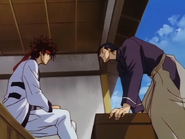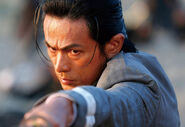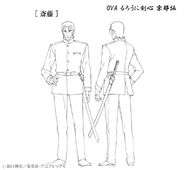No edit summary Tag: Visual edit |
|||
| Line 73: | Line 73: | ||
Saitō's skills are so great that all of the battles that he fought against Kenshin during the Bakumatsu were inconclusive. Furthermore, as stated by Kenshin, defeating Saitō is an extremely difficult feat that cannot be accomplished merely by defeating his signature Gatotsu; his real strength lies in the strict code of the Shinsengumi, which he lives by: "''Aku Soku Zan''" (Slay Evil Immediately), which explains why he is able to defeat Seiryū, even after the latter figures out a major weakness in his Gatotsu, seemingly nullifying it. In keeping with this, his seemingly inflexible sword technique is compensated for via his vast array of unorthodox strategies and a talent for improvised weaponry (such as using a belt to disarm a sword-wielding Kenshin or a coat in an attempt to break the latter's neck). |
Saitō's skills are so great that all of the battles that he fought against Kenshin during the Bakumatsu were inconclusive. Furthermore, as stated by Kenshin, defeating Saitō is an extremely difficult feat that cannot be accomplished merely by defeating his signature Gatotsu; his real strength lies in the strict code of the Shinsengumi, which he lives by: "''Aku Soku Zan''" (Slay Evil Immediately), which explains why he is able to defeat Seiryū, even after the latter figures out a major weakness in his Gatotsu, seemingly nullifying it. In keeping with this, his seemingly inflexible sword technique is compensated for via his vast array of unorthodox strategies and a talent for improvised weaponry (such as using a belt to disarm a sword-wielding Kenshin or a coat in an attempt to break the latter's neck). |
||
| − | Unlike every single swordsman, other than perhaps [[ |
+ | Unlike every single swordsman, other than perhaps [[Udō Jin-e]], Saitō says that the code of the Shinsengumi, i.e. "Aku Soku Zan", allows him to enjoy all of his battles, regardless of how disadvantaged he may be. In his own words, Saitō was: "the only one of the Shinsengumi who was considered immortal" (Manga Act 196). True to this, he has come back from many a situation in which he should have been killed, including the crumbling down of Shishio Makoto's headquarters. |
==History== |
==History== |
||
Revision as of 00:07, 6 November 2017
Saitō Hajime is the former captain of the third unit of the Shinsengumi, a hitokiri, and currently a special agent for the Meiji Government's Department of Internal Affairs. Having a long-standing rivalry with Himura Kenshin since their days on opposite sides of the Bakumatsu, Saitō nevertheless holds a begrudging respect for the rurouni and has come to his aid on assignment more than once, acting as a ruthless ally and the voice of cynical reason in the Kenshin-gumi's major battles.
Appearance
Saitō is a particularly tall and lean man with long limbs and a long face. His eyes are piercing and narrow and his short black hair is neatly slicked back with the exception of four forelock bangs which others have compared to cockroach antennae. During the bloody revolution he wore a samurai style ponytail, but cut it off after he became an agent of the police.

Saitō as he appeared during the Bakumatsu
Though he frequently wore the traditional Shinsengumi uniform during the Bakumatsu, Saitō is almost always seen in his blue policeman's uniform during the Meiji era.
In the anime, Shishio Makoto described him as "a man who looks like a wolf." This could be due to his gatotsu sword form, his overall lean appearance and angled golden eyes.
As was the same with the real-life Saito, this fictional incarnation of him is known for his unusual height for a Japanese man of his era, being just about 5 feet eleven inches tall. The real life Saito was known to stand out in a crowd due to his tall stature.
Personality
A former captain in the loyalist Shinsengumi, Saitō has had a long time rivalry with Himura Kenshin, a former manslayer of the Imperialist cause. As a result of his involvement in the Ikedaya Affair, he and his Shinsengumi comrades successfully prevented the burning of Kyoto by an extremist faction of the Ishin Shishi. Nevertheless, the pro-shogunate forces were ultimately defeated and he was forced to go into hiding.
He adherently lives by the Shinsengumi code "Aku Soku Zan" (悪即斬 -literally " Evil Immediately Slay", but more poetically rendered as "Swift Death To Evil"), though he never shows much regard for human life, at some points even letting on that he likes to kill. He is rather morbid and arrogant. Nevertheless, none of these character flaws prevent him from being a superb investigator and fighter. He expects those involved in the military, whether Shinsengumi swordsmen or Meiji era policemen, to carry out their duties without letting their personal feelings interfere.
He believes in peace and order, even in the society created by his former enemies. Throughout the series, to uphold this new peace, Saitō has often been shown as the foil of Kenshin who walks and carries out his duties in the shadows of society in his own way; following his lifelong code of purpose with devotion, Saito is the man who does the necessary dirty work, killing off the despicable and those beyond saving. Anyone he considers to be corrupt or despotic, he targets for elimination, in the honor of his country and his fallen men.
Though normally serious, Saitō's slight sense of humor is morbid and slightly sadistic, shown as he uses his sword to casually attempt to stab Sanosuke Sagara in the butt through the roof of the horse carriage the two of them and Kenshin were riding on.
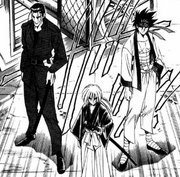
Saitō, Kenshin and Sano join forces in the battle against Shishio.
During the Kyoto Arc, Saitō joins forces with Kenshin to fight against Shishio Makoto. However, he considers Kenshin to be more of an adversary rather than an ally. Later, after acknowledging Kenshin's vow to never kill again, Saitō decides to put an end to their rivalry.
Saitō is an able observer and a quick analyst (working as a spy for the Meiji government). In addition to being a skilled swordsman, he is revealed to possess immense physical strength when he pummels the herculean Sagara Sanosuke in a hand-to-hand fistfight. He considers Sanosuke to be a dimwitted amateur with mild potential, due mostly to Sano's lack of insight.
He is also revealed to be married to a woman named Tokio (who has never been seen). Saito has been shown to be somewhat annoyed when forced to admit to being a married man, as the idea of domestic life conflicts with his cold and terrifying image and almost demonic affect. He remarks at one point early on that he has a fondness for soba, a simple noodle dish.
Saitō is highly recognizable by his narrow eyes, "spider-like" strands of hair in front of his forehead (he is also often said to resemble a wolf), his propensity for smoking and the katana (Japanese sword) which hangs from his left side.
Relationships
Himura Kenshin - His rival for numerous years. Upon realizing and acknowledging that his once bitter enemy is no longer Hitokiri Battōsai, but just Himura Kenshin, he refuses an offer from Kenshin to settle their disputes once and for all and, in doing so, puts an end to the age-long rivalry.
Shinsengumi - Bakumatsu faction. Served as the captain of the third squad. He was among the best swordsmen of the group with Okita Souji.
Tokio - His wife who made his favourite food.
Mishima Eiji - His adopted son whom he and his wife raised after the death of his family.
Sagara Sanosuke - Saitō and Sanosuke have a mutual resentment toward each other, but they also show deep, albeit silent and begrudging, respect for the other's abilities. It could be first seen when Sanosuke spoiled Shishio's plans by destroying the Rengoku, thus thwarting his plans to fire bomb Tokyo.
Abilities
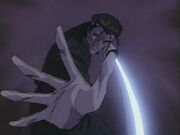
Saitō in the "Isshiki" stance for gatotsu
Saitō mastered all the various techniques of the "Shinsengumi-Kenjutsu." An ambidextrous fighter, he is able to skillfully switch his stance and dominant hand at any time to face any opponent and likewise confuse them. The "Hirazuki" (left handed horizontal stab) technique that Saitō's Gatotsu resembles is based on the real fighting style of the Shinsengumi. Although the Gatotsu is the only named technique that Saitō uses, he has been able to perform the same technique in different stances.
The First Stance (Isshiki) is the standard, shoulder-level ground attack. Saitō prepares by dropping into a partial crouch, both knees bent, left arm drawn back and right arm extended forward; he grasps the kashira (endcap of the tsuka, or hilt) of his sword with his left hand and rests the tips of the fingers of his right hand (usually the thumb) on the blade near the kisaki (blade's tip). The Second Stance (Nishiki) is a downward-striking attack. The direction of the Nishiki thrust is narrower than in Isshiki, as well. The Third Stance (Sanshiki) is an upward-striking attack. Prepared identically to the Isshiki, he uses it to intercept an opponent assaulting him from above, directing his blade into the air instead of immediately forward. It is stated by Sanosuke that the Gatotsu has stabbing power that rivals the Kuzuryūsen. Furthermore, the sheer force behind the Gatotsu is such that, even after being gravely wounded by both Usui and Shishio, Saitō was able to blast apart a steel door that Sanosuke admitted was too thick to be destroyed by a Futae no Kiwami.
However, Saitō also possesses another stance: Gatotsu Zero Stance (Zeroshiki). Zeroshiki is an attack performed at point-blank range using all of his upper body strength. This stance, unlike the first three, requires no prior preparation or footwork. Saitō's sword techniques are considered quite deadly, as the Gatotsu has only a precious few blind spots to be exploited. Despite the apparent inflexibility of using one attack repeatedly, it has many useful applications. Furthermore, the motion of the Gatotsu can also be used barehanded.
There also appears to be an overhead version of the Gatotsu which Saitō called "the true form of the Gatotsu". It is possible that this is a stronger and faster version of the Gatotsu, since Saitō stated that he was no longer holding back when he used it on Kenshin.

Saitō knocking Sanosuke into the air with an uppercut
Besides his overwhelming ability with a sword, Saitō is extremely well-versed in hand-to-hand combat. His fighting style is more commonly defensive, seeing through his opponent's attacks and blocking, to which he has a very solid guard, or evading before countering with jūjutsu and aikidō maneuvers, performing quick strikes to key weak points followed by body-locks and throws. When fighting offensively, his styles resembles boxing as he possesses amazing footwork and quick relentless jabs. His prowess was made evident when he decided to have a fist fight against Sanosuke and still beat him almost effortlessly. It was then pointed out that he purposely dodged Sanosuke's bad shoulder in order to keep the fight fair. Saitō also tends to integrate hand-to-hand combat techniques into his swordplay, using them to cover blind spots in his sword technique and to give himself additional offensive and defensive coverage. His physical might is deceptively great, as he has been able to take a direct and serious blow in the face from Sanosuke unfazed and, in addition, strike him back with even stronger blows. He is also remarkably fast, able to catch Shishio off-guard and successfully strike him before he could react, his attack only failing to kill Shishio because the latter's head was protected by a metal headband.
Besides his superior fighting skills, Saitō is also extremely analytical in battle, much like Hiko Seijūrō, who can exploit his opponent's physical weaknesses quite easily, such as Kenshin's over-reliance on his speed. While not his specialty, Saitō is occasionally able to exploit his opponent's mental vulnerabilities as well, which he did by mocking Usui's cowardly move in backing down from his vendetta against Shishio, then finishing him off as he prepared to retaliate in anger.
Saitō's skills are so great that all of the battles that he fought against Kenshin during the Bakumatsu were inconclusive. Furthermore, as stated by Kenshin, defeating Saitō is an extremely difficult feat that cannot be accomplished merely by defeating his signature Gatotsu; his real strength lies in the strict code of the Shinsengumi, which he lives by: "Aku Soku Zan" (Slay Evil Immediately), which explains why he is able to defeat Seiryū, even after the latter figures out a major weakness in his Gatotsu, seemingly nullifying it. In keeping with this, his seemingly inflexible sword technique is compensated for via his vast array of unorthodox strategies and a talent for improvised weaponry (such as using a belt to disarm a sword-wielding Kenshin or a coat in an attempt to break the latter's neck).
Unlike every single swordsman, other than perhaps Udō Jin-e, Saitō says that the code of the Shinsengumi, i.e. "Aku Soku Zan", allows him to enjoy all of his battles, regardless of how disadvantaged he may be. In his own words, Saitō was: "the only one of the Shinsengumi who was considered immortal" (Manga Act 196). True to this, he has come back from many a situation in which he should have been killed, including the crumbling down of Shishio Makoto's headquarters.
History
Kyoto Arc
Saitō first appears masquerading as a medical herb seller outside the Kamiya dojo. After incapacitating Sagara Sanosuke (who saw through his trick), he flees, but leaves clues to alert Himura Kenshin of his presence. When Kenshin departs for a duel with Akamatsu (another assassin under the influence of a corrupt politician named Shibumi), Saitō himself appears at the Kamiya dojo, posing as a police officer who urgently needs to speak with Kenshin.
When Kenshin arrives at the dojo, he notices Saitō and becomes angry, revealing Saitō's true identity as the former 3rd Captain of the Shinsengumi. They duel, and as Saitō gains the upper hand, Kenshin reverts back to Battosai the manslayer and breaks his sword. With the odds against him, Saito disarms him with his belt and uses his jacket to try and snap Kenshin's neck, but he intercepts Saito's attempt by striking him with his scabbard. Okubo appears just as they were about to finish and stops the duel, apologizing for testing Kenshin to see if he was still a skilled enough swordsman to face Shishio.
He obeys his superior and leaves after saying that Kenshin Himura is utterly useless, but Himura Battosai would be relatively useful Saitō disappears. He reacquires a sword and is later seen slaying Akamatsu and Shibumi under his Shinsengumi principle of Aku, Soku, Zan, "Slay Evil Immediately". Saitō's next appearance is prior to Okubo's assassination is him at a soba restaurant where he sneezes three times sending soba down his face, grossing out the waitress. He wonders if the Battosai will make the choice and go to Kyoto.
When Kenshin Himura is shown at the Metropolitian Police Department building, Saitō is either called or ends up there after the Secretary of the Interior Okubo is killed by Shishio's right hand man, Seta Sōjirō. After a discussion about Okubo's goals for Japan to become a nation state from the last person that saw Okubo alive, Yamayoshi (Morisuke) from Fukushima, Saitō and Kenshin have a discussion about what must be done.
"Saitō, I'd like to know what it is you're planning to do," Kenshin asks him in the dark shadowed hallway of the Police department. Saitō stops and replies simply. "There's only one path, Kyoto. That's where Shishio is. Simple isn't it?" He simply walks away, leaving Kenshin to come to the invevitable choice, he must go to Kyoto and stop the man (Shishio).
After Kenshin leaves for Kyoto from Tokyo leaving Kamiya Kaoru almost catatonic, Saitō is next seen trying to persuade Sanosuke to remain in Tokyo and not get involved with the Shishio confrontation. He shows Sano how faulty his weak defense and reliance on his toughness were, but is unsucessful, and only manages to make the rooster head more set on going to center of the current chaos surrounding the Rurouni. He largely operates to fill in the hole Okubo's death left, but manages to subtly nudge Shinomori Aoshi into joining in on the upcoming war.
A village called Shingetsu is where Saitō shows up next, claiming that Kenshin should already be in Kyoto or making his way towards there. He also states that he had not ventured there himself, because he was waiting for his men to arrive. In the meantime he is in Shingetsu village to check on his informant, Eiji's elder brother who is killed by Senkaku, a minion of Shishio Makoto. He and Kenshin end up confronting Shishio, but the fight turns into two separate fights for Kenshin with Saitō watching from the sides waiting for a chance to kill Shishio.
Due to the presence of Seta Soujirou, he is unable to carry through with this idea because he cannot read how the boy will react. Shishio and his courtesan Yumi escape as Kenshin faces off against Soujirou and ends up destroying both his Sakabatō and Soujirou's blade, a Nagasoni Kotetsu (a high quality sword according to Yumi at the end of Episode 37). Saitō has to step in because Eiji attempts to finish off what Kenshin started, by killing off Senkaku who was responsible for not only the brother's death, but the parents as well. Saitō stops him, flings him into a wall, and says something along the lines of "don't make my job any more difficult" or "add anymore paperwork to my work load". From there Eiji is sent to stay with Saitō's wife, Tokio.
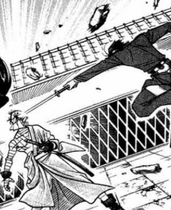
Saitō's ambush fails.
Saitō appears again during the Kyoto Arc to fight against Shishio Makoto. During this arc, Saitō fights and has his men kill many of Shishio's soldiers. He himself kills the second most powerful warrior amongst the Juppongatana, Uonuma Usui, but suffers deep leg wounds during that battle. However, he is defeated by Shishio as his ambush on him fails, due to the protective armor on Shishio's head. Shishio had a hachigane (forehead guard), saving him from being ripped apart from a Gatotsu when Saito struck him to the head. Shishio revealed that because he was shot in the head and burned in the past, he protected his forehead to avoid repeating the same mistake. Afterwards, Shishio easily deflected every attack Saitō threw at him, including his best move the Gatotsu Zero Stance (likely due to Saito's leg injuries from Usui, which slowed him down, allowing Shishio to observe his movement much more easily). After Shishio perishes, Saito is thought to be dead after the explosion of the battlefield, but persistently survives and recruits Sawagejō Chō to become his lackey, much to Cho's dislike.
Jinchu Arc

Saitō defeats Yatsume.
Saitō is sent to arrest Yukishiro Enishi and he ends up helping Kenshin in his fight against Enishi's allies, defeating Yatsume Mumyōi and breaking his arm and teeth, although Kenshin prevents Saito from killing the latter. He also fights against the first of the four Sushin guards of Enishi's second-in-command and defeats him even after he exploits Gatotsu's weak spot as Aoshi, Sanosuke, and Yahiko take care of the rest. His police force apprehend Enishi and Heishin, after which Saitō is transferred to another city to work after rejecting the challenge of Himura Kenshin, claiming that he won't enjoy settling the score with an assassin that doesn't kill. He is very briefly shown in the colored special Haru ni Sakura, where an older Kenshin asks Aoshi to tell him of his whereabouts and state of health as he learns that Sanosuke has traveled to Mongolia. This sidestory was collected into a few Kenshin-related books, and in the Kanzenban with Yahiko no Sakabato.
In Live-action film

The Gatotsu stance.
He is played by Yusuke Eguchi and can very well be looked upon as the most powerful character in the film. The film begins when Saitō led his group fighting in the war before Kenshin vanished shortly after their defeat at Toba-Fushimi. Ten years later, as a high ranking member of the police department, he meets Kenshin again and the two end up dueling in the presense of Yamagata Aritomo, with Saitō handling the fight surprisingly easily, due to Kenshin's refusal to become Hitokiri Battosai. In addition, he is in pursuit of Takeda Kanryū, a very successful businessman, suspected of smuggling opium. Under the laws of the Meiji Era, however, Saitō is unable to search Kanryū without a warrant. Eventually, however, after Kenshin and Sanosuke fight their way through Kanryū's soldiers and find themselves facing Kanryū who is in possession of a gatling gun, Saitō attacks Kanryū head on and ends up arresting him, despite the constant barrage of gunfire directed towards him. However Saito didn't hold the end of the handle of his sword during the time he did Gatotsu. The real Gatotsu works when the user holds the end of the handle of the sword.
Eguchi reprise his role in sequels to film: The Great Kyoto Fire and The End of a Legend.
In the beginning of second film when Saito and his colleagues raided to find crimnal's whereabouts when two of colleagues didn't come out so Saito led his men to track down
Saito discovered that the bandaged man was Shisho Matoko whom he thought was dead in the war. Before Shishio fled, he order his men to drop the captured cops which had been hung up, causing them to fall into the fire below. With the compound disintegrating and fire burning, Saito could neither pursue Shishio nor save his men.
Later, while meeting Kenshin, Saitō showed him the corpses of the cops that Shishio sent back to them, making it clear how serious a threat Shishio was. He said to Kenshin that he expected to see the latter in Kyoto, where the next step of Shishio's plans was most likely to take place.
After Kenshin defeated Sawagejō Chō, Saitō learned from this Katana loving, hired assassin that Shishio's plan was to attack Kyoto and burn the city. Saitō and Kenshin agreed they should confront Shishio's men at Kyoto to prevent the destruction of the city. However, they didn't exactly work together, but somehow fought with the attackers in their own ways. Having dispatched the attackers, Saitō and Kenshin both realized burning Kyoto was merely a distraction, while the main event will take place in Tokyo.
Development & Reception
Saitō Hajime (1844-1915) was an actual historic figure of the Meiji era, and a number of details presented in the fictional characters are based on facts.
When creating the character, Watsuki used the concept of "anti-hero", much like The Punisher, Frank Castle, of Marvel Comics fame, from whom he drew inspiration. Watsuki considers Saitō as the "curse" of the villains in the series as he always ends defeating the enemies who believe they are the strongest.[2] The Gatotsu sword technique that Saitō uses in the series is similar to the description of his original sword technique, but is purely fictional, and not entirely accurate to real sword fighting.
In Japan, many fans of the Shinsengumi complained to Watsuki about the personality of Saitō Hajime.[1] However, as the series continued Saitō became one of the most popular character of the series as he ranked 3rd in the two last Shonen Jump popularity polls[3] and 2nd in the "Who is the best enemy of Kenshin?" polls.[4]
Some concepts of the Rurouni Kenshin version of Saitō Hajime were used in is the fighting game series The Last Blade in the character of Keiichiro Washizuka, a unit leader of the Shinsengumi, a police-like group during the Bakumatsu era. The character also had a similar sliding thrust technique to the Gatotsu.[5]
Several publications for manga, anime, video games, and other media have provided praise and criticism on the character. Anime News Network praises the character it is made for perfectly. They celebrate his introduction, past and fight scenes, and Japanese voice actor as one of the best moments of the series.[6] They also state that although he appears only for a few seconds in Samurai X: Reflection, he is truly menacing; they also note his new design.[7]
Quotes Typical of Saitō
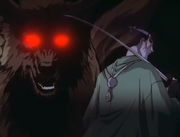
Saitō Hajime, the last of the Wolves of Mibu.
"You can tame a dog with food, you can tame a man with money, but there is NOTHING, that can tame a Wolf of Mibu!" - Saitō Hajime to Shibumi, just before he kills him, Manga chapter 55
"Aku Soku Zan - To slay evil immediately was the justice shared by the Shinsengumi and the Hitokiri." - Saitō Hajime, Episode 31, English sub.
"Now that the last of the three great imperialists and the greatest leader of the Meiji Government is gone, the political world is only filled with third rate idiots with no real power." Saitō Hajime, Episode 31 english dub.
"You little fool, killing for the purpose of seeking revenge has been forbidden since the sixth year of the Meiji," Saitō Hajime, Episode 37 english dub to Aeiji of Shingetsu village.
"Doesn't matter if you kill him now, either way, this guy's going to end up on the execution stand with the added bonus of torture. You'll prefer it over delivering the final blow to an unconcious man. It's a much more painful way to go," Saitō smirks like a wolf waiting for its dinner to make a mistake as he says this line. Still Episode 37, english dub. Misao responds humorously with "he's a demon."
"A dog that fled before the battle started has no reason now to bark so majestically!" - Saitō Hajime to Usui, Episode 49 'The Wolf Destroys the Shingan'.

